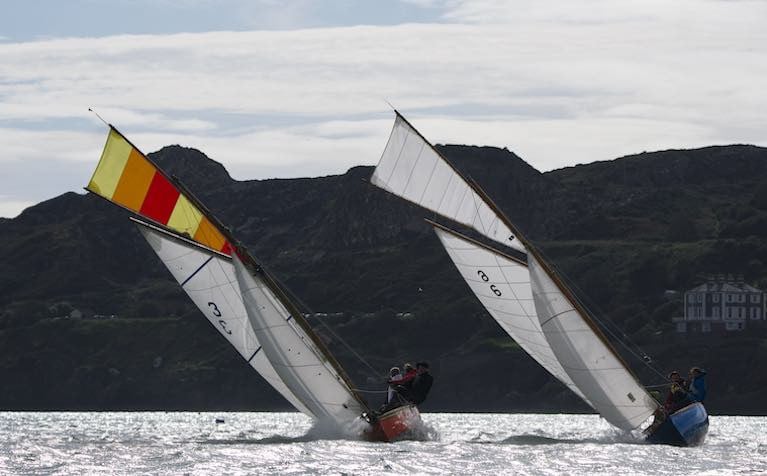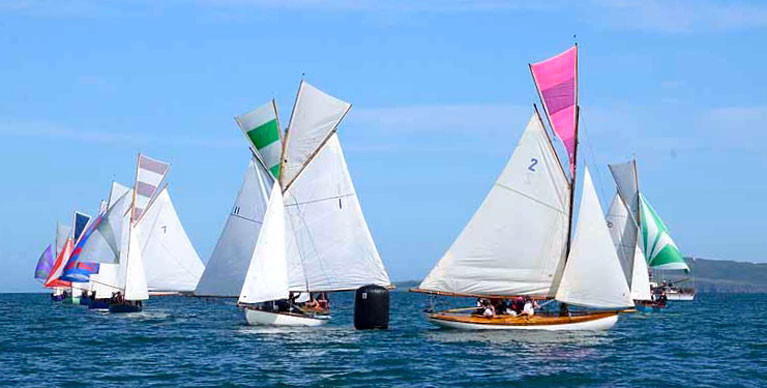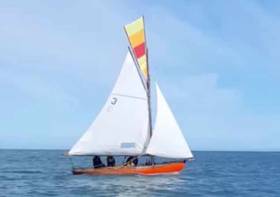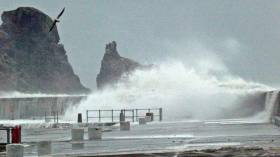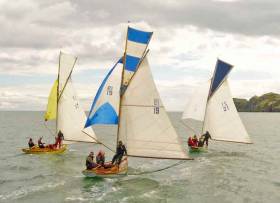Displaying items by tag: Howth 17
Water Wags, Dublin Bay 21s & Howth 17s: Classic Irish Boatbuilding is Pandemic Panacea
In times of stress like this, there is nowhere more soothing than a well-organised but not unduly fussy timber workshop where each day's harmonious effort shows a tangible result. And of all such workshops, there's nowhere so healthily absorbing – both mentally and physically - than a place where they build wooden boats. For not only is something of beauty being created in time-honoured style in a material for which we feel an instinctive affinity, but at the end of it all you have a work of practical art in which it is possible to sail away, and for a little while at least, escape the tedious everyday concerns of shore life.
That said, it is a fact that in Ireland the best of our classic classes continue to thrive, and have new boats built, not only because the owners are enthusiastic appreciators of ancient style, but because the boats provide excellent one-design racing. The importance of good and demonstrably fair sport should never be under-estimated, and thus at various stages of the building, the normal mood of calm creation is interrupted by the scheduled visit of the class measurer.
Happily, things are now at such a steady throughput of production that the Visit Of The Measurer is a social occasion of ceremony and well-formatted routine rather than a nightmare, as the secret is to have the measurer involved from a very early stage, which is easily achieved in a country the size of Ireland.
 Just inhale gently but steadily – the sweet interior of a new-built classic wooden hull at its best with Shindilla in Athlone. Photo: Cathy Mac Aleavey
Just inhale gently but steadily – the sweet interior of a new-built classic wooden hull at its best with Shindilla in Athlone. Photo: Cathy Mac Aleavey
Thus there are several timber boatbuilding or restoration projects underway at the moment, and while there are some we'll be looking at in due course, today it is intriguing to draw comparisons between jobs under way in Athlone, Howth and Kilrush.
Along the Shannon above Athlone, we recently lost one of Ireland's greatest-ever boatbuilders with the death at the age of 94 of Jimmy Furey of Mount Plunkett near Leecarrow in Roscommon. Busy to the end, in his later days he worked with several boatbuilding development projects with former Olympic sailor and round Ireland record-holder Cathy Mac Aleavey, together with another of those seemingly born-to-it boatbuilders who emerge in the Athlone region, Dougal McMahon.
Working with Jimmy, a project had been coming along to build a replacement for the well-worn Dublin Bay Water Wag Shindilla, a 1932 veteran originally built for Ninian Falkiner who was later a noted offshore cruiser and Commodore of the Royal Irish YC, while Shindilla stayed within the extended family as his daughter married into the Collen family, and it is the Collens who have ensured that Shindilla lives anew. The work has been completed in a shed provided by Dougal's father in Athlone, who may have been an engineering bridge-builder by profession, but he's no slouch at the wooden boatbuilding himself.
 The 1963 Tyrrell-built Harklow is Dougal McMahon's current restoration project
The 1963 Tyrrell-built Harklow is Dougal McMahon's current restoration project
With Shindilla completed, Dougal, is spending the rest of the winter on a restoration job in a bigger shed in Portumna on the classic Shannon cruiser Harklow, originally built by Jack Tyrrell of Arklow for sailing legend Douglas Heard (he won the first Helmsman's Championship in 1946) and now owned by Half Ton Racing ace Johnny Swann.
HOWTH 17 BUILDING
Johnny grew up in Howth, and just round the corner from his family home, recently-retired airline captain Gerry Comerford is building what looks like being the strongest Howth 17 ever constructed, the completely new Anna, which is named for his mother. With laminated backbone and frames, and king-size stainless steel floors make up by a steel-working genius in Clontarf, you might well be concerned that Anna will come out over-weight, but this doesn't seem to be a bother among Howth 17 folk.
 The latest Howth 17 Anna is currently under construction by owner Gerry Comerford at his home in Howth
The latest Howth 17 Anna is currently under construction by owner Gerry Comerford at his home in Howth
For they well remember that many years ago when all the local cruisers had to be weighed to comply with Channel Handicap Measurement requirements, the Howth 17s got hold of the load cell for a day or two to weigh their own boats at launching time. They found that despite the mostly very old boats being only 22ft 6ns LOA (they go back to 1898), there was a half-ton range in their measured weights. Yet, to everyone's surprise, it was the class's most renowned light airs flyer which was the heaviest boat of all…
 Singing from the same hymn sheet – Howth 17 measurer Rupert Jeffares with new owner-builder Gerry Comerford and Anna. Photo: Ian Malcolm
Singing from the same hymn sheet – Howth 17 measurer Rupert Jeffares with new owner-builder Gerry Comerford and Anna. Photo: Ian Malcolm
Regardless of weight, Anna will certainly have the correct dimensions, as class measurer Ruper Jeffares – for many years the Executive Secretary of Howth Yacht Club – lives close, just down the hill, and dropping by Gerry's house to see how Anna is coming along is always of interest, for in their long existence, only two other Howth 17s have ever actually been built in Howth, and that was way back in 1988.
 At an early stage, it was abundantly evident that Anna was going to be built extra-strong. Photo: Ian Malcolm
At an early stage, it was abundantly evident that Anna was going to be built extra-strong. Photo: Ian Malcolm
Thus although the building of Anna has been going on for four years, now that Gerry has retired from the day job he'd better get a move on. For as soon as the lockdown eases, current Howth 17 National Champion Shane O'Doherty (he won it in August with the 1900-vintage Pauline) will resume his popular guided Hill of Howth Hiking Tours, and "Traditional Boat-building with Gerry and Anna" could easily become a must-see stopover on the way over the hill, but a formidable distraction from Work in Progress….
DUBLIN BAY 21s BORN AGAIN IN KILRUSH
Meanwhile, across country in Kilrush on the Shannon Estuary, Steve Morris and his team - having launched the newly-built electrified Galway Bay gleoiteog Naomh Fanchea last week – have now returned to full focus on the latest pair of re-born Dublin Bay 21s, Maureen and Estelle, for the DB21 project by Hal Sisk and Fionan de Barra.
With boatbuilders of the enormous experience of Steve himself, together with Dan Mill and James Madigan (who is of Kilrush, but was much involved with the Ilen project in Limerick) the actual building has an educational element, and apprentice Kate Griffiths was working and learning today (Tuesday) with Dan on Maureen, battening off the new hull prior to laminating the light timbers (two per bay) between the main frames, while nearby James was fairing out Estelle's new deck, which is of laminated Douglas fir beams and carlins.
 The 1903 Dublin Bay 21 Maureen continues to re-emerge in Kilrush with apprentice boatbuilder Kate Griffiths (behind boat) and master shipwright Dan Mill. Photo: Steve Morris
The 1903 Dublin Bay 21 Maureen continues to re-emerge in Kilrush with apprentice boatbuilder Kate Griffiths (behind boat) and master shipwright Dan Mill. Photo: Steve Morris
For sure, there are modern epoxies and other chemicals involved in this form of boatbuilding, just as there is with Anna across in Howth and also – though to a very much lesser extent - with Shindilla in Athlone. But nevertheless, in all cases, the abiding impression of the dominant material in use is wood, glorious wood.
 James Madigan at work n the new deck on the DB21 Estelle. Photo: Steve Morris
James Madigan at work n the new deck on the DB21 Estelle. Photo: Steve Morris
"Olympic Nightmare Course" Gives Howth 17 Lambay Sailors a Dream Race
The Olympic sailing dream is of competition on a sterile racing area with weak to non-existent tides, well clear of any special wind effects that a nearby coastline and an island or two might provide, while of course using a meticulously-set Committee Boat start line and a cleverly-designed course to test several points of sailing. That's the way they want it. Yet if that's their dream - their perfect ideal - then Howth Yacht Club's traditional sixteen nautical miles of Lambay Race must be Olympic sailing's stuff of nightmares.
The original Lambay Course – raced at least since 1904, and probably earlier - was simply though Howth Sound inside Ireland's Eye after a pier start from Howth Harbour, then nor' eastwards to the east point of Lambay. Officially, it's The Nose, but few remember to call it that, they just call it the East Point, as we've a Nose of Howth already, and that's quite enough to smell the coffee on any one day.
 Sixteen miles of sailing perfection – the classic Lambay course can serve up all sorts of conditions, but on Saturday it provided record times
Sixteen miles of sailing perfection – the classic Lambay course can serve up all sorts of conditions, but on Saturday it provided record times
The north side of Lambay seems like the Far Side of the Moon for most sailors, even those from Howth which is only seven miles away. And as you head west to double the island, there are various impairments to ease of navigation, such as Carrickdorish Rock and Harp Ear.
These are matters of even more concentration if you're beating against a westerly. But concentrating purely on sailing along there is difficult anyway, as Lambay is a natural wonder where the abundant wildlife - some of it on surprisingly spectacular cliffs - is augmented by a troupe of wallabies (don't ask), and Ireland's only colony of black rats, a cute little fellow who nevertheless would make life difficult for your average gannet settlement.
 Getting going for record times – Leila and Zaida (Tom Houlihan) with freed sheets, on course with a fair tide with Ireland's Eye put astern. Photo: Annroi Blaney
Getting going for record times – Leila and Zaida (Tom Houlihan) with freed sheets, on course with a fair tide with Ireland's Eye put astern. Photo: Annroi Blaney
However, the Fingal gannet seems a tougher proposition than those from elsewhere. Having established his first neighbourhood colony on the Stack at Ireland's Eye back in 1989, when that got crowded his descendants and relatives not only started spreading onto the main island itself regardless of its predators, but they set up an offshoot on a big rock close under the cliffs on the other side of Lambay six miles to the north.
That has prospered so much that they appear to have bludgeoned their way onto Lambay itself through being the Neighbours from Hell for poor little rattus rattus, who is now on the endangered species list. As for the wallabies, they can't be too pleased, as they used to top the Lambay attractions chart until these rock-star gannets came along.
Brian Maguire of Hyberno Droneworks follows the fleet.
All these interesting things are going on along the Far Side of the Moon, aka the north side of Lambay, making it difficult to think only of sailing - let alone racing tactics - in a locality notorious for its flukey winds and tricky tides. As a result, when the Lambay Race is on the agenda, the Howth sailing community is a bit thin on the community spirit, as the Single-minded Racing Purists think it's a very dodgy proposition in the first place, whereas the Broad-minded Historically-Concerned Philosophers think it's central to the very ethos of Howth sailing, an event which must be sailed in its traditional form each year as an Act of Worship .
 Rita (John Curley & Marcus Lynch) was first to Lambay, but was halfway down the fleet in the final reckoning. Photo: W M Nixon
Rita (John Curley & Marcus Lynch) was first to Lambay, but was halfway down the fleet in the final reckoning. Photo: W M Nixon
With such contrary opinions, the Lambay Race race has sometimes been messed about over the years, with extra marks being added to make it look more like a modern course. But in the difficulties of our current situation, the 1898-founded Howth Seventeens saw an opportunity. They wanted to celebrate getting a dozen boats of their ancient 20-strong fleet finally afloat despite 2020's truncations, and the best way seemed to be a race the traditional straightforward 16-mile Lambay Course on Saturday 5th September, as the tides suited – flood going north and favourable ebb coming back - and they could do it as their own thing, without trying to make an all-comers regatta out of it.
 The dark side? Gladys, owned by HYC Commodore Ian Byrne and Eddie Ferris, finds a bright spot on the north side of Lambay. Photo: W M Nixon
The dark side? Gladys, owned by HYC Commodore Ian Byrne and Eddie Ferris, finds a bright spot on the north side of Lambay. Photo: W M Nixon
It made for a busy day at Howth in the day's brisk westerly, as a race of the Fingal Series for cruiser-racers went off around 1000 hrs, the Howth 17s buzzed northwards towards Lambay – just able to carry their topsails – in a starting sequence beginning at 1130 hrs, and then towards 1430 hrs as the Puppeteer 22s and the Squibs were squaring up for their weekly Saturday afternoon race, didn't the Howth 17s come roaring back down the Sound again with the full ebb under them after probably the fastest Lambay Race the class has ever recorded.
Yet far from being left on their own to get on with it, in this most peculiar sailing season they'd had an escort fleet dominated by the local flotilla of dark blue Seaward 23s and 25s carrying various photographers and a film team from TG4. For the word had got out that in this bleak year, a dozen Seventeens racing round Lambay would be a sight to cheer anyone up. And it was vintage stuff throughout, with real power to the dense-air wind at times, and flashes of vivid sunlight interspersed with curiously rain-free passing clouds, one or two so black they had the look of The End of Days about them.
 Close encounter. Rosemary (12) and Pauline in classic juxtaposition at the Taylor's Rocks buoy. In March 2018, Rosemary had become the "flatpack boat" after her shed was smashed in during Storm Emma, while Pauline was almost lost in a fire. Yet in 2020 they're both fighting fit again, with Pauline winning the close-fought 2020 Nationals. Photo: W M Nixon
Close encounter. Rosemary (12) and Pauline in classic juxtaposition at the Taylor's Rocks buoy. In March 2018, Rosemary had become the "flatpack boat" after her shed was smashed in during Storm Emma, while Pauline was almost lost in a fire. Yet in 2020 they're both fighting fit again, with Pauline winning the close-fought 2020 Nationals. Photo: W M Nixon
But for connoisseurs of Howth Seventeen sailing and the wonders of the Fingal coast, it was pure magic throughout. After an extremely fast and wet reach northward, appropriately it was the granny of them all, Howth 17 No 1 Rita (John Curley & Marcus Lynch) which was first at Lambay. But the wind flattened almost completely at the Nose such that the eight leading boat concertinaed into a straight line abreast, and first out of the traps in a private breeze which took them very close to Carrickdorish were the Massey/Toomey/Kenny syndicate in Deilginis with Keith Kenny on the helm, and Dave Mulligan with Sheila.
 The going is good. Deilginis has taken the lead, and found her own flash of sunshine with it. Photo: W M Nixon
The going is good. Deilginis has taken the lead, and found her own flash of sunshine with it. Photo: W M Nixon
Thereafter, Deilginis played it very cool on the short but position-setting beat along the north coast on Lambay, not getting too far offshore where there was a boat-stopping sea running and the tides were all over the place, yet not getting too far into the alluringly smooth water inshore, where the wind might suddenly disappear completely.
They were first to reach the most northerly turn at the buoy marking Taylor's Rocks off Lambay's northwest corner, and had quite a decent gap on Sheila. But Dave Mulligan had to put in a virtuoso performance on the long reach back to Howth, as the pack were right on his tail.
 The chasing pack are (left to right) Pauline, Sheila and Rosemary. Overall, they finished Sheila 2nd, Pauline 3rd and Rosemary 4th. Photo: W M Nixon
The chasing pack are (left to right) Pauline, Sheila and Rosemary. Overall, they finished Sheila 2nd, Pauline 3rd and Rosemary 4th. Photo: W M Nixon
As it turned out, they were having enough in-fighting to let him build his lead a bit, but there was no way he could make any dent on the gap to the flying Deilginis, which was literally racing against time as her topsail – which had been setting perfectly on port tack heading north – was all over the place on starboard tack heading south, though enough of it stayed working for her crew to claim they'd been deploying a clever topsail-scandalising trick to de-power the sailplan in the stronger gusts.
 With Lambay astern and the wind temporarily softening, Deilginis continues to maintain her lead on Sheila. Photo: W M Nixon
With Lambay astern and the wind temporarily softening, Deilginis continues to maintain her lead on Sheila. Photo: W M Nixon
Whatever, they maintained their lead to finish in two hours 36 minutes and 14 seconds, which may well be a Howth 17 Lambay record. And as they tacked onto port to get into the harbour, lo and behold but wasn't the topsail suddenly setting perfectly again…..Sheila was just over a minute astern, then came 2020 champion Pauline (Shane O'Doherty, Ian McCormick and Michael Kenny) and Rosemary (George Curley, David Jones & David Potter, with the four leaders finishing within two minutes.
On handicap (a very import element in the continuing strength of the class) the winner was Echo (Bryan & Harriet Lynch) from Tom Houlihan's Zaida, with Sheila and Pauline re-appearing in the listings at 3rd and 4th. In a more complete season, it would be hoped that there would seldom be much overlap between scratch and handicap.
 Deilginis storming home to win, with Portmarnock's Velvet Strand and the Pormarnock Hotel in the background. When Deilginis was being built by James Kelly of Portrush in 1907, the hotel was St Marnoch's House, home of renowned racing skipper Willie Jameson. Photo: W M Nixon
Deilginis storming home to win, with Portmarnock's Velvet Strand and the Pormarnock Hotel in the background. When Deilginis was being built by James Kelly of Portrush in 1907, the hotel was St Marnoch's House, home of renowned racing skipper Willie Jameson. Photo: W M Nixon
But in this weird year, the six Howth Seventeens which didn't appear in the top four under either system in the Lambay Race 2020 seemed happy to adopt the attitude of the New England whaling skipper who went clean round the world without so much as seeing a whale, let alone catching one. He said he'd had a helluva fine sail.
Howth 17 Lambay Race 2020 results (scratch)
1st Deilginis (Massey, Toomey & Kenny) 2:36:14; 2nd Sheila D.Mulligan) 2:37:18; 3rd Pauline (S.O'Doherty, I. McCormick & M Kenny) 2:37:44; 4th Rosemary (G.Curley, D.Jones & D Potter) 2:38:10.
Handicap
1st Echo (B. & H. Lynch 2:25:31; 2nd Zaida (T.Houlihan) 2:26:17; 3rd Sheila 2.37:18; 4th Pauline 2:37:44.
 With sailing so restricted in 2020, every event attracted extra attention, and there were as many support boats as racers when the Howth 17s went round Lambay. Photo: W M Nixon
With sailing so restricted in 2020, every event attracted extra attention, and there were as many support boats as racers when the Howth 17s went round Lambay. Photo: W M Nixon
The Howth 17 Nationals 2020 saw five good races sailed – a pier starter on Friday evening, and four committee boat open water races on Saturday – with the sunny nor’east wind holding up enough for the four open water contests to provide some cracking racing, although it never developed into the hearty sea breeze which might have been expected.
But even with the gentler conditions, there was still just enough power for proper closely-contested sport, and the best competitive showing saw everyone in the fleet of eleven across the finish line within three minutes, with some private contests separated by less than five seconds.
 At times the wind looked like it was on its last gasp instead of developing into a decent sea breeze, but always it returned with just enough strength for close racing. Age comparison in close quarters with (left to right) Aura (1898, Ian Malcolm), Pauline (1900, Shane O’Doherty & partners), Gladys (1907, Eddie Ferris & Ian Byrne), Orla (2018, sailed by Gerry Comerford) and Deliginis (1907, Massey, Toomey & Kenny). Photo: Conor Lindsay
At times the wind looked like it was on its last gasp instead of developing into a decent sea breeze, but always it returned with just enough strength for close racing. Age comparison in close quarters with (left to right) Aura (1898, Ian Malcolm), Pauline (1900, Shane O’Doherty & partners), Gladys (1907, Eddie Ferris & Ian Byrne), Orla (2018, sailed by Gerry Comerford) and Deliginis (1907, Massey, Toomey & Kenny). Photo: Conor Lindsay
 Hazy days of summer – Howth may have developed since 1898, but the Seventeens remain resolutely unchanged. Photo shows Pauline, Rosemary and Sheila, with topsail of Deiliginis beyond. Photo: Trish Nixon
Hazy days of summer – Howth may have developed since 1898, but the Seventeens remain resolutely unchanged. Photo shows Pauline, Rosemary and Sheila, with topsail of Deiliginis beyond. Photo: Trish Nixon
Overall winner, with the final race the decider, was Shane O’Doherty sailing the 1900-built Pauline. He’s known to some as The Mountainy Man, as he runs an outfit called Shane’s Howth Hikes, which in normal times (remember them?) takes visitors to the peninsula on quite energetic walking tours (there’s an electric bike option as well) of the Hill of Howth and its more extraordinary features, most of which the locals take for granted or don’t even know about.
Yet even in the busiest visitor times in non-lockdown years, Shane always keep Saturdays free for sailing while a colleague looks after the tours, for he regards racing with the Howth 17s as an essential part of the Howth experience, and it re-invigorates his love of the place.
 HYC Commodore Ian Byrne and Eddie Ferris with Gladys (14) look to have done well with the pin start, but others had taken over the lead by the finish. Photo: Trish Nixon
HYC Commodore Ian Byrne and Eddie Ferris with Gladys (14) look to have done well with the pin start, but others had taken over the lead by the finish. Photo: Trish Nixon
For now, that love is total and unquestioning, as conditions suited the Clancy of Kingstown-built Pauline to perfection for the Championship, and she finished two points clear – after that final race decider - of the defending champion Deilginis (Massey, Toomey, Kenny) of 1907 vintage, with Dave Mulligan’s 21st Century “new” boat Sheila third, and another 1907 boat from Kelly of Portrush, the George Curley, Davy Jones and David Potter-owned Rosemary, notching fourth with a scorecard which included the win in Race 4 and a third in Race 5.
 Rosemary (George Curley, Davy Jones & David Potter) wins Race 4 from Sheila (Dave Mulligan). Rosemary looked to be a write-off after Storm Emma’s shoreside damage in March 2018, but ace Fingal boatbuilder Larry Archer worked miracles to bring her back to life. Photo: Trish Nixon
Rosemary (George Curley, Davy Jones & David Potter) wins Race 4 from Sheila (Dave Mulligan). Rosemary looked to be a write-off after Storm Emma’s shoreside damage in March 2018, but ace Fingal boatbuilder Larry Archer worked miracles to bring her back to life. Photo: Trish Nixon
 Lambay beyond – as unspoilt as the most remote Hebridean island – while light-wind flyer Rita (No 1, John Curley & Marcus Lynch) tests an ultra-flexible topsail yard. Rita won the first race, but an uneven performance thereafter kept her out of the frame, and she was fifth overall on scratch. Photo: Conor Lindsay
Lambay beyond – as unspoilt as the most remote Hebridean island – while light-wind flyer Rita (No 1, John Curley & Marcus Lynch) tests an ultra-flexible topsail yard. Rita won the first race, but an uneven performance thereafter kept her out of the frame, and she was fifth overall on scratch. Photo: Conor Lindsay
While the Howth Seventeens may be the world’s oldest one-design keelboat class, particularly when it’s further qualified by still having the original rig and with the added restriction of all the boats being in the one harbour, nevertheless their personnel lineup is encouragingly supra-national and broad-minded in its outlook.
Thus Shane O’Doherty’s partners in the boat are Michael Kenny -who couldn’t be there as he’s based in Warsaw - and Sutton Dinghy Club Commodore Ian McCormick, who was away in West Cork on a Sportsboat campaign. But being The Mountainy Man, the skipper recruited on his hillside with some heather (Wayne Heather to be precise) and some holly (his daughter Holly O’Doherty). With Brendan O’Brien on the strength to add a surname of unimpeachable Irish sailing distinction, it was all systems go for success for Pauline, with the skipper revealing further insight at the outdoor prize-giving, as his T-shirt told us “Harbours rot ships and men”.
 The Mountainy Man and his heather and holly……winning skipper Shane O’Doherty (left) with crew Wayne Heather, Holly O’Doherty and Brendan O’Brien. Photo Howth 17 class
The Mountainy Man and his heather and holly……winning skipper Shane O’Doherty (left) with crew Wayne Heather, Holly O’Doherty and Brendan O’Brien. Photo Howth 17 class
One of the secrets of the Howth Seventeens’ longevity is their determined application of a parallel handicap system to ensure that other boats emerge out of the cannon fodder division to get their place in the sun. It was very well demonstrated this time round as the winner was another Clancy 1900 boat, Anita owned by David O’Connell (Phibsborough) in partnership with helm Muige Karasahin (she’s from Istanbul), with crewing by Elizabeth Jakobson (from Latvia) and Susan Morgan (Sutton).
Anita – re-built by Paul Robert and his team at Les Ateliers de l’Enfer in Douarnenez in Brittany in 2019 after being destroyed by Storm Emma in Howth in March 2018 – was certainly finding her feet as the series progressed, and logged a scratch second in the last race. But even with that, she was sixth overall on scratch in the final tally, yet that became a clear win with the handicaps in an interesting case of sailing for Byzantium within sight of a house where the family of W B Yeats lived for two years in the early 1880s.
 Sailing for Byzantium…..with Muige Karasahin of Istanbul on the helm, Anita (D. O’Connell & M Karasahin) was overall winner of the handicap division. Virtually a total loss after Storm Emma in March 2018, Anita was re-built by Paul Robert’s Les Atelier de l’Enfer (The Workshops of Hell) in Douarnenez in Brittany Photo: Conor Lindsay
Sailing for Byzantium…..with Muige Karasahin of Istanbul on the helm, Anita (D. O’Connell & M Karasahin) was overall winner of the handicap division. Virtually a total loss after Storm Emma in March 2018, Anita was re-built by Paul Robert’s Les Atelier de l’Enfer (The Workshops of Hell) in Douarnenez in Brittany Photo: Conor Lindsay
The clear division between scratch and handicap continued down the listing, with Tom Houlihan’s Zaida taking second, though there was then an element of overlap as Rosemary (fourth on scratch) was handicap third while scratch winner Pauline was fourth, the double results give everyone at least one good race.
As for sailing enjoyment in a summer when travel is restricted, the weather was such that you could find whatever you wanted off Howth, as the view to the east was of Irelands Eye which looks like a piece of Connemara transferred to the Irish Sea, to the north Lambay would not look amiss in the Hebrides, to the west the dunes of Portmarnock are reminiscent of the Vendee, and to the south with a fore-shortened lens against the strong sunshine, you could be looking at the French Riviera as the narrowed eyes take in the flank of the Hill of Howth and the Wicklow Mountains beyond.
Howth 17s Nationals 2020 (Scratch) Results
1st Pauline (S. O’Doherty, I. McCormick & M. Kenny): (4),3,1,3,1: 8pts; 2nd Deilginis (Massey family, M.Toomey, K, Kenny) 3,1,2,4, (5): 10 pts; 3rd Sheila (D.Mulligan) 2,(7),4,2,6: 14pts; 4th Rosemary (G, Curley, D. Jones, D.Potter) 16pts.
Howth 17 Handicap
1st Anita (D. O’Connell & M. Karasahin), (2), 1,1,1,1: 4 pts; 2nd Zaida (T. Houlihan) 1,2,2,2, (3) 7 pts; 2rd Rosemary (Curley, Jones, Potter) (3), 3,3,3,2: 11 pts; 4th Pauline (O’Doherty, McCormick, Kenny) (7), 6,4,5,4.
 Who needs to go away on holiday when the view southward, from the race area past the Hill of Howth and on towards the Sugarloaf in the Wicklow Mountains, could pass as the French Riviera? Photo: Conor Lindsay
Who needs to go away on holiday when the view southward, from the race area past the Hill of Howth and on towards the Sugarloaf in the Wicklow Mountains, could pass as the French Riviera? Photo: Conor Lindsay
Howth Seventeens Crank into Action for National Championship in 123rd Year This Weekend
The Howth 17s have been racing in their “little piece of Connemara that’s somehow in Leinster” for 122 years. And when some years ago they decided to make their annual championship into something special, they re-titled it the Howth 17 Worlds. But within the powers-that-be - where a certain lack of light-heartedness is the default mode - it was decreed that they mustn’t do that again. So the following year the Howth 17 Galactic Championship was staged….
Thus for some years now a sort of truce seems have existed over the class’s determination to call its annual major the National Championship, and 2020's comes up this weekend, with the 1907-built Deilginis (Massey, Toomey & Kenny partnership) defending the title.
 The defending champions. The syndicate on Deilginis ensure maximum speed through total concentration, and the use of liquid adjustable ballast when needed
The defending champions. The syndicate on Deilginis ensure maximum speed through total concentration, and the use of liquid adjustable ballast when needed
And for those who would claim to find some oddity in a one-harbour class having a Nationals, the Seventeen sailors will magisterially point out that not all the participating crews live in the village.
On the contrary, some of them reputedly come from the bandit country on the other side of the Hill of Howth at Sutton, while there are even a few from nearby Ireland in the trackless wilds to the west beyond the peninsula’s isthmus frontier. And unbelievably, the class’s racing is so good that it draws in one or two aliens from south of the Liffey.
With the word from the west in Connacht being something along the lines that all those who would normally go to Mallorca have descended on Roundstone, the shy creatures who sail Seventeens have put all thoughts of the crowded Atlantic seaboard out of their heads, and they’re focusing on racing in home waters which suddenly seem the most exotic in Ireland.
 It goes with the territory….while Howth YC Commodores are permitted to sail in other boat types, they’re expected to have more than a passing acquaintance with the soul of the club through the Howth 17s. Current Commodore Ian Byrne, though best-known as the owner of the Sunfast 32 Sunburn, solves the problem through part-ownership of the Seventeen footer Gladys, which he regularly races and is seen here shining with the Commodore at her launching
It goes with the territory….while Howth YC Commodores are permitted to sail in other boat types, they’re expected to have more than a passing acquaintance with the soul of the club through the Howth 17s. Current Commodore Ian Byrne, though best-known as the owner of the Sunfast 32 Sunburn, solves the problem through part-ownership of the Seventeen footer Gladys, which he regularly races and is seen here shining with the Commodore at her launching
Admittedly in current circumstances not all the boats have yet been put afloat, but they’ll muster a dozen or so for the big one, with a user-friendly programme of a first race in Friday night (August 7th), then it’s hard going on Saturday with four races scheduled, while Sunday morning is kept in reserve in case there’s any slippage. But the tradition is that it’s done and dusted by Saturday night, upon which everyone springs to the mainbrace, and great is the splicing thereof (within socially-distant compliance, of course).
 Orla was built in 2018 in France using a boatbuilding school scheme. Owned by Ian Malcolm, she is currently raced by Gerry Comerford as he works on completing his own new Howth 17 in his personal Men’s Shed beside his house.
Orla was built in 2018 in France using a boatbuilding school scheme. Owned by Ian Malcolm, she is currently raced by Gerry Comerford as he works on completing his own new Howth 17 in his personal Men’s Shed beside his house.
While Deilginis has been showing her traditional speed, Gerry Comerford in the Ian Malcolm-owned new boat Orla has had a much-celebrated win, while Ian Malcolm himself has found new speed in his 1898-built Aura.
The word is it’s all down to a change of topside colour. During what seemed like many decades (it was actually forty years), Ian perfected an attractive pale cream finish for his topsides, and black anti-fouling below. For those who asked, the answer was that this was the colour scheme of a pint of Guinness.
Yet everyone knows that the essence of Guinness is that it should be a slow procedure, and there were definitely times when Aura’s performance reflected this.
But last year, with things a bit hectic at launching time, Aura’s owner grabbed the nearest tin of topside enamel in his rather wonderful worshop/boatshed, and Aura emerged with topsides of a sort of orange colour, and it was immediately obvious she was faster.
 The secret ingredient. It’s reckoned Aura’s new speed in 2020 is due to a change of livery to this “go-fast blue” after forty years of “slow-is-best” Guinness colours.
The secret ingredient. It’s reckoned Aura’s new speed in 2020 is due to a change of livery to this “go-fast blue” after forty years of “slow-is-best” Guinness colours.
So this year she has a new colour yet again, a rather stylish shade which has already been dubbed “go fast blue” by the rest of the class, as Aura has been in the frame many times, quite often with the bullet, in this truncated season.
Whether go-fast-blue works in a National Championship remains to be seen. But when you’ve managed to transpose a real sense of Connemara to Howth for the hollyers - rather than drag yourself there through thickening crowds - then all things are possible.
After Storm Emma wrought extensive destruction through the seven Howth Seventeens stored in their much-damaged shed on Howth’s East Pier at the beginning of March 2018, it was feared that several of the boats – which since 1898 have been the very heart of Howth sailing – would be written off writes W M Nixon.
But in the end only one – David O’Connell’s Anita built in 1900 by James Clancy of Dun Laoghaire – was assessed as needing a complete re-build.
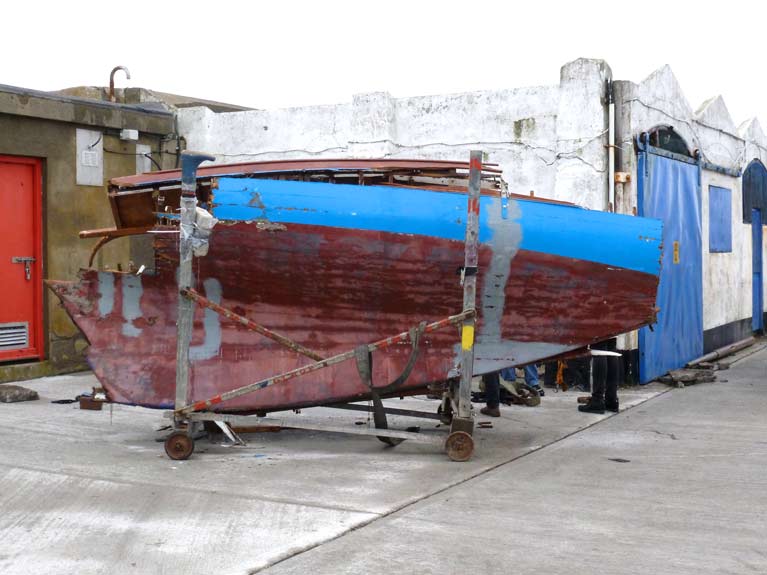 Definitely a re-build…….Anita as she was on 5th March 2018. Photo: W M Nixon
Definitely a re-build…….Anita as she was on 5th March 2018. Photo: W M Nixon
Anita is a very special Seventeen - for very many years from 1965 onwards she was the personal boat of the late Brendan Cassidy, the long-time Honorary Secretary of HYC. So the Howth Seventeen Association set about making resources available for her re-build, and the class’s action man Ian Malcolm negotiated a deal in France through the Government boat-building school scheme, whereby the customer has only to cover the cost of the materials, while the school provides the premises and the trainee labour under the direction of qualified instructors.
The boat-building schools like to test their pupils and staff through building a variety of boats. So although Skol ar Mor near the Morbihan has already built the new Howth 17 Orla, for Anita’s re-birth the Howth 17 Association went to Paul Robert’s Les Ateliers d’Enfer in Douarnenez in Brittany.
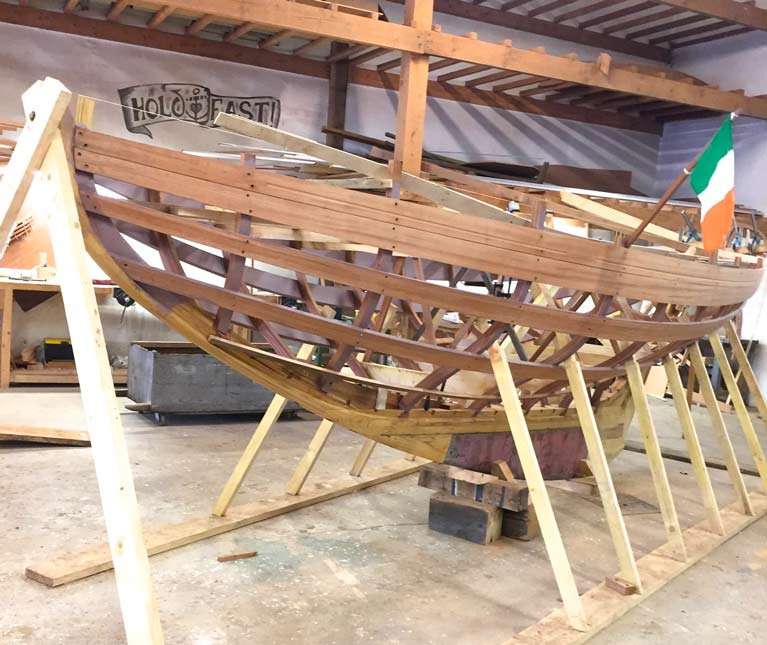 The re-born Anita taking shape in January 2019. Photo Ian Malcolm
The re-born Anita taking shape in January 2019. Photo Ian Malcolm
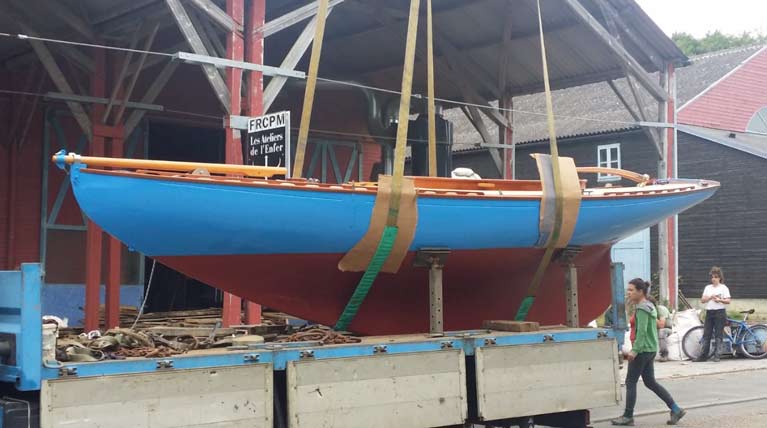 Second life. The re-born Anita emerges from the Workshops of Hell. Photo: Paul Robert
Second life. The re-born Anita emerges from the Workshops of Hell. Photo: Paul Robert
It is called the “Workshops of Hell” through its location in the midst of what was formerly the fish-smoking area of this ancient fishing port, where for centuries at least 25 massively malodourous smokeries used to make the place seem truly hellish. But today the boat-building school is a little piece of heaven, and when the re-born Anita emerged this week to spend a symbolic day afloat in the bay, she was clearly a divine bit of work.
The re-born Anita is to return to Howth via road trailing and ferry, and all being well she’ll be back in her home port by Saturday evening.
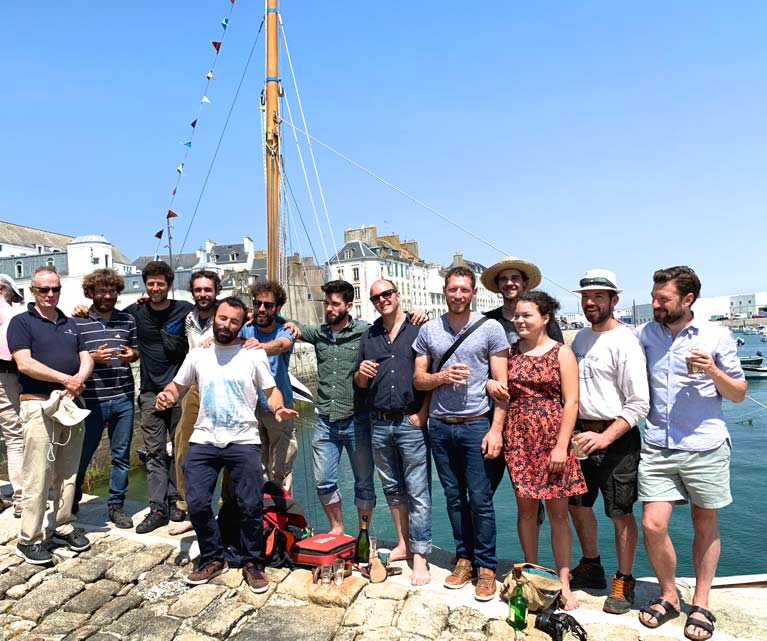 Anita would originally have been built by two men and a boy (at most) in 1900, but in 2019 it took this team of apprentices (Ian Malcolm on left) to do the job. Photo: Judith Malcolm
Anita would originally have been built by two men and a boy (at most) in 1900, but in 2019 it took this team of apprentices (Ian Malcolm on left) to do the job. Photo: Judith Malcolm
It’s only two months since Storm Emma swept Ireland, with Force 12 Easterlies spreading havoc and blizzards and rumours and tall tales of total disaster along the East Coast writes W M Nixon. One such tall tale which began circulating almost immediately was that the 20-strong 1898-founded Howth 17 class had lost all of the seven boats which had been laid up for the winter in the time-honoured fashion in the Long Shed down at the end of the sea-swept East Pier.
The shed’s roof had been stove in by enormous breakers, and many of the first reports talked of “matchwood” within. But once the storm had moved on and some cooler investigation became possible, the word was more hopeful. Nevertheless it was soon clear that a real community effort would be needed to extract the boats – or the remains of boats - as soon as possible, as there was danger of more damage being inflicted by the next lot of bad weather, with the building expected to collapse even further.
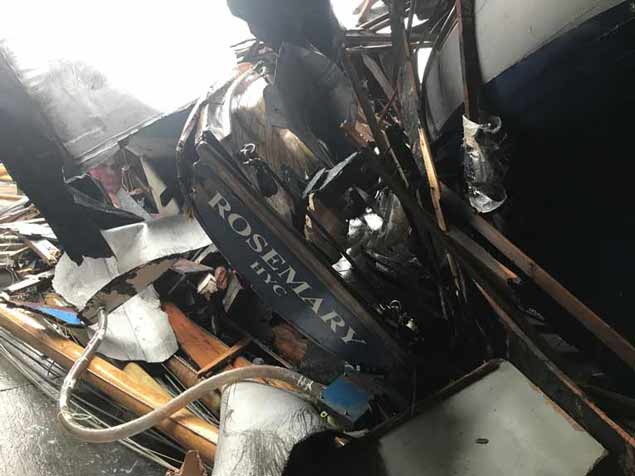 It didn’t look good – Rosemary as she was on March 1st
It didn’t look good – Rosemary as she was on March 1st
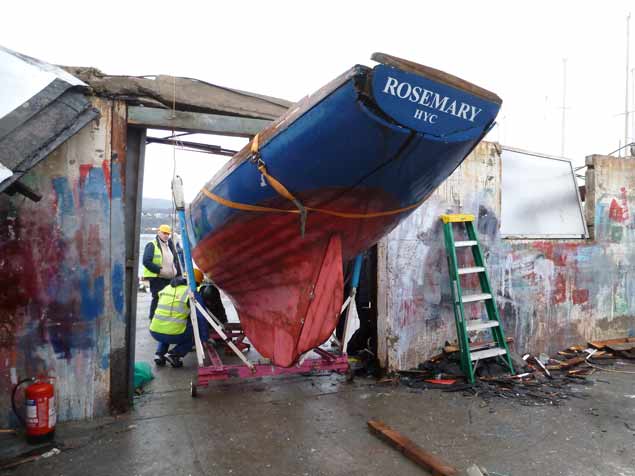 With willing helpers, Rosemary is already looking saveable on March 3rd……Photo: W M Nixon
With willing helpers, Rosemary is already looking saveable on March 3rd……Photo: W M Nixon
 …..and is carefully extracted from the remains of the shed, with her flattened after-deck much in evidence. Photo: W M Nixon
…..and is carefully extracted from the remains of the shed, with her flattened after-deck much in evidence. Photo: W M Nixon
The volunteers assembled the way they do when the chips are down, and in one very long but well worthwhile day’s work, the boats were extracted and gathered safely in the Howth YC compound. There, a realistic assessment could begin by Larry Archer, the multi-talented boatbuilder who is one of the many specialists who are prepared to bring an extra level of dedication to this very special old class whose owners vary enormously in every way, including their availability of resources.
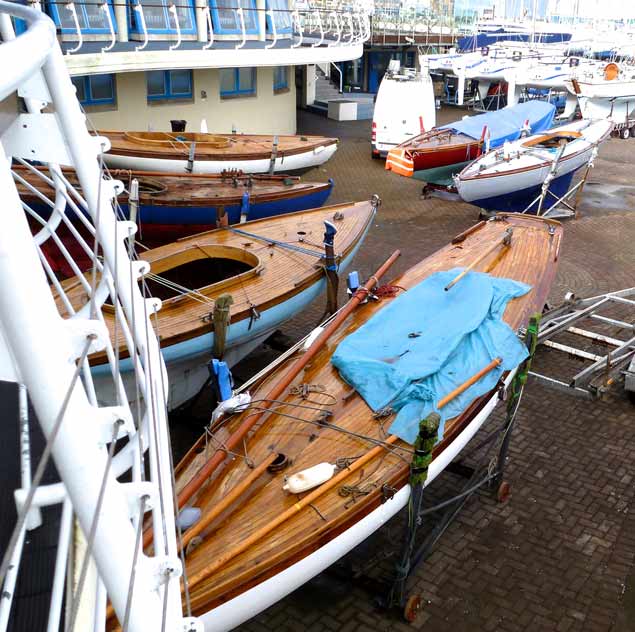 A good day’s work. The six survivors of the Long Shed collapse looking remarkably well at Howth YC, but repairs – some very extensive - were needed in every case. Photo: W M Nixon
A good day’s work. The six survivors of the Long Shed collapse looking remarkably well at Howth YC, but repairs – some very extensive - were needed in every case. Photo: W M Nixon
He was able to confirm that by some miracle, five boats had suffered relatively superficial - or at least quickly repairable –damage. Of the other two, Anita (Number 6, built 1900) would be a write-off were she not a classic, and therefore is a re-build proposition using her original keel. And as for Rosemary (Number 12, built 1907), last seen apparently flattened under another boat and bits of roof - she was in fact eminently restorable, but it would take until mid-summer to finish a proper job on her, after he’d done the smaller jobs on the other boats.
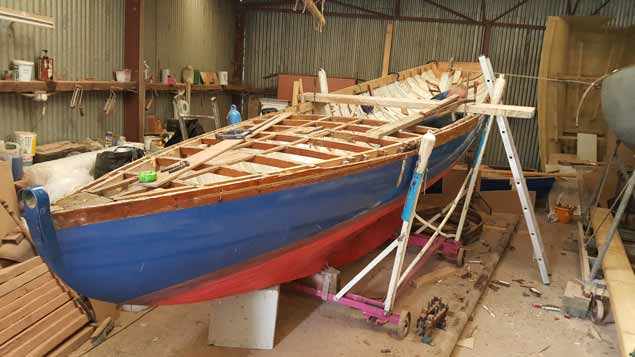 Once she was in Larry Archer’s shed, Rosemary’s badly-damaged deck could be removed………..Photo: Davy Jones
Once she was in Larry Archer’s shed, Rosemary’s badly-damaged deck could be removed………..Photo: Davy Jones
Like everyone else, the Howth 17s have been slowed back by the longest winter anyone can ever remember, but their first scheduled race of the year on Tuesday April 24th saw boats come to the line. Then last Saturday afternoon (April 28th) they had topsails appearing for the first time in 2018 (they aren’t used in evening races), and with six boats racing, Ian Malcolm with the 1898-built Aura led the way to signal the class’s continuing recovery. But perhaps more importantly, in second place was the 1988-built Erica, one of the “Long Shed Survivors”, sailed by Shay Gilna.
Meanwhile, the images from Larry Archer’s shed in the depths of Fingal show how the 111-year-old Rosemary is going through her time in intensive care. The big stages of the restoration can seem to happen quite quickly, but it is the proper finishing, including the installation of new floors, and the re-building of the deck, which will take time.
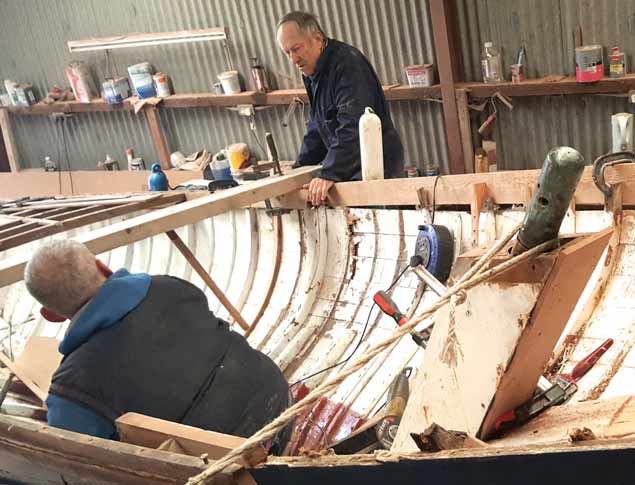 …..and Larry could get a clear idea of everything that was required. Photo: Davy Jones
…..and Larry could get a clear idea of everything that was required. Photo: Davy Jones
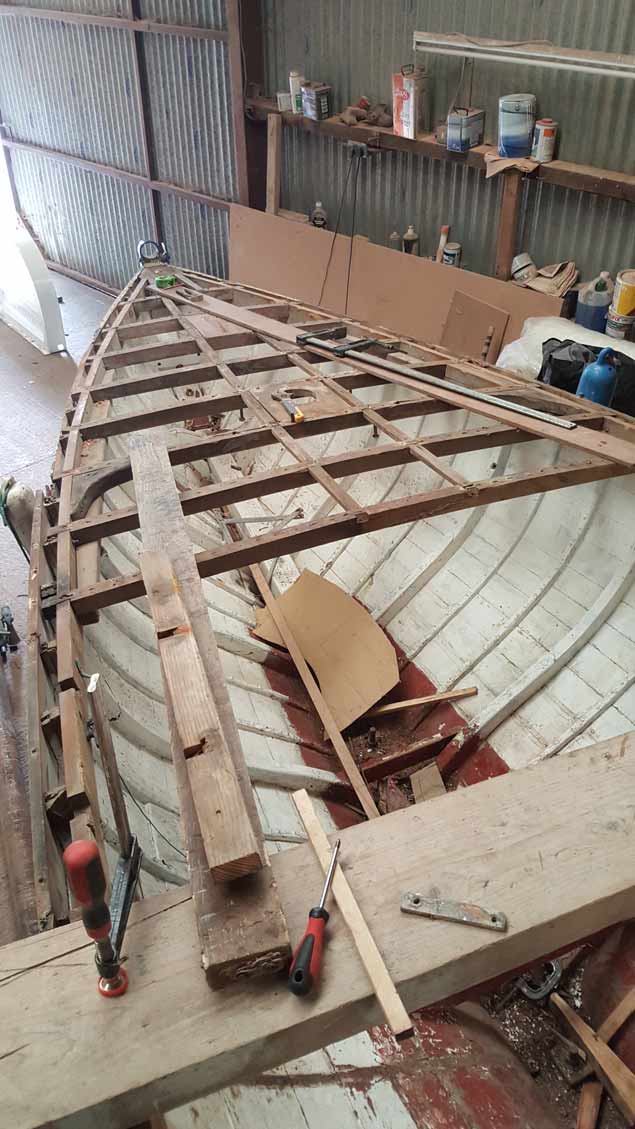 The forward timbers of the original deck may be re-used…..Photo: Davy Jone
The forward timbers of the original deck may be re-used…..Photo: Davy Jone
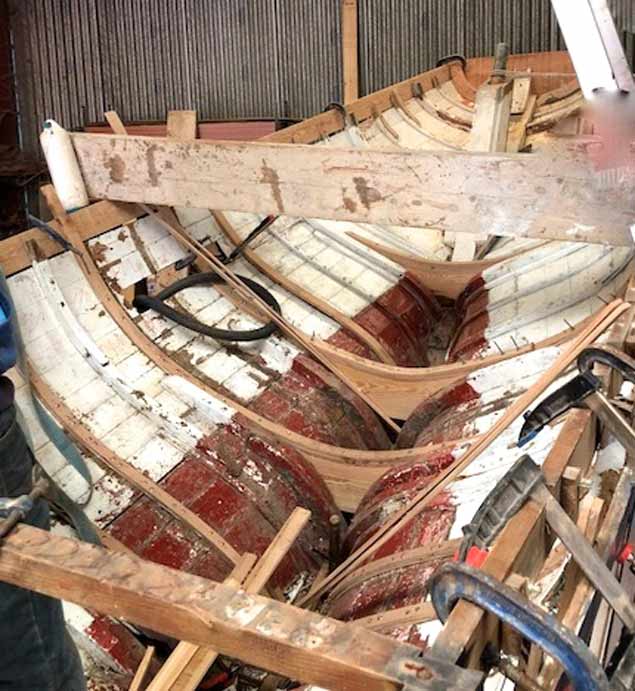 ….but down aft, the laminating-in of new floors is essential for restoring Rosemary to full strength. Photo: Trish Nixon
….but down aft, the laminating-in of new floors is essential for restoring Rosemary to full strength. Photo: Trish Nixon
But as of yesterday, the vitally important newly-laminated floors were being installed to put the backbone back in the old girl, and all being well, owners George Curley and Davy Jones (they’ve been in partnership for 45 years) will be there competing with Rosemary in the Howth 17 “Worlds” in August.
Howth 17s Celebrate Twenty Years Since Their Epic Centenary Sail
These days, we’ve become accustomed to the historic Howth 17s of 1898-vintage – the world’s oldest keelboat class still sailing as originally designed – putting in admired appearances at classic boat festivals at home and abroad writes W M Nixon. But just twenty years ago, with the Class’s Centenary looming, they tended to be homebirds, though a couple had been transported to the famous Brest Festival in France, while some had made significant voyages, and one had even been used as a honeymoon cruise yacht.
Nevertheless when it was suggested early in 1998 that a representative trio of Howth 17s should be road-transported to Carrickfergus, where the first five of the class had been built by the famous John Hilditch in the winter of 1897-’98, in order to mark the Centenary properly, there were those who were convinced that the old boats would be shaken to bits on such a journey. But as the Massey brothers of the 1907-built Deilginis had a road-trucking business, they decided to take their own boat and Paddy & Rachel Cronin’s Gladys on a low loader, despite the fact that both boats had actually been built by James Kelly at Portrush on Ireland’s north coast. However, Ian Malcolm had the real McCoy, the 1898 Hilditch-built Aura, and he took her north on the class’s one and only road trailer.
So the show was on the road, but twenty years ago the negotiations for the Good Friday Agreement were reaching a crucial stage in Belfast at exactly the same time, and peace was by no means a given. Yet the Howth 17 people were determined that their three-boat delegation – with many friends and supporters - should be in Carrickfergus precisely a hundred years to the day after the first five boats had undertaken their maiden voyage to their home port after launching from Hilditch’s yard into Carrick’s history-laden harbour on Belfast Lough.
 Aura and Gladys (Paddy Cronin) bid farewell to Carrickfergus Castle before setting off on their Centenary Sail home to Howth
Aura and Gladys (Paddy Cronin) bid farewell to Carrickfergus Castle before setting off on their Centenary Sail home to Howth
Thus in 1998 their boats were being launched into Carrickfergus marina and getting the masts stepped even as the political negotiations at Stormont near Belfast entered their final most difficult stage. Yet although the sun shone, it was bitterly cold with a northeast wind and snow flurries. And while the Seventeeners and their supporters were warmly welcomed with a Civic Reception by Mayor of Carrickfergus David Hilditch (a distant relative of the original boatbuilder) and hospitability received to lunch by the Fairy Class of 1902-vintage at Royal North of Ireland Yacht Club across the lough at Cultra, any sailing had to be restricted to the relatively sheltered waters off Carrickfergus and its historic 12th Century Norman Castle.
 Deilginis (Massey syndicate) heading south off the County Down coast while conditions were still moderate. Photo: Damien Cronin
Deilginis (Massey syndicate) heading south off the County Down coast while conditions were still moderate. Photo: Damien Cronin
 Small boats, big wide sea – Damien Cronin helming Gladys with Deiliginis following, and 80 miles to sail through the freezing night to Howth. Photo: Paddy Cronin
Small boats, big wide sea – Damien Cronin helming Gladys with Deiliginis following, and 80 miles to sail through the freezing night to Howth. Photo: Paddy Cronin
The boats having survived to such a great age, the impression given was that they wouldn’t be expected to replicate the achievement of the original flotlla of 1898 by sailing home the 89 open miles from Carrickfergus to Howth. After all, the conditions a hundred years earlier had been gentler, but for 1898 the forecast was for a further freshening of the nor’easter, with the strong possibility of snow.
Yet after completing all their planned activities on Belfast Lough, suddenly on the Sunday afternoon the three little boats simply sailed for home. Nick Massey and his nephew Ian were on Deilginis, Ian Maclolm and Davy Jones sailed the true Centenarian Aura, and Paddy Cronin and his son Damian swept off into the freezing evening in Gladys.
 Aura, with Ian Malcolm and David Jones aboard, starting to experience more demanding conditions as they approach the South Rock Lightship. Photo: Damien Cronin
Aura, with Ian Malcolm and David Jones aboard, starting to experience more demanding conditions as they approach the South Rock Lightship. Photo: Damien Cronin
The blustering fair wind made for a fast passage, but the temperatures froze in the dark. However, while there were some massive snow-and-wind-filled clouds about, they managed to avoid them. By sunrise next morning, they’d swept into Howth harbour, their crews almost completely frozen but still functioning enough to grab their moorings and get ashore to de-frost in Howth Yacht Club with a full Irish breakfast, while the word came through that back around Belfast Lough, the coastline was now covered in a mantle of snow.
 Aura making knots while a snow-shower beyond tries to build itself into a mini-storm. Photo: Damien Cronin
Aura making knots while a snow-shower beyond tries to build itself into a mini-storm. Photo: Damien Cronin
This past weekend, that very special Centenary Sail has been celebrated in Howth Yacht Club twenty years on, with the six sailors who did it honoured at in an informal gathering of classmates and well-wishers in HYC on Friday night, while this morning (Monday) marks the exact 20th Anniversary of the appearance at dawn of the three little sails from beyond the horizon to the north, an achievement which inaugurated a busy and very successful Centenary Season.
Not even the damage sustained by seven boats on Howth’s East Pier during Storm Emma on Friday 2nd March 2018 has daunted the Class’s remarkable spirit
In the twenty years since, the Howth 17s have gone from strength to strength. In 1998, it was thought remarkable that they had achieved the Centenary at all. But now, at 120 years old, their busy annual programme continues to provide sixty races ever season, their numbers are greater than ever with 20 boats in class and new boats building, and they regularly appear at major classic boat festivals, with the most recent in 2017 being Morbihan Sailing Week in France in May, and the Classics Division for the Kingstown 200 Cup in the Volvo Dun Laoghaire Regatta in July.
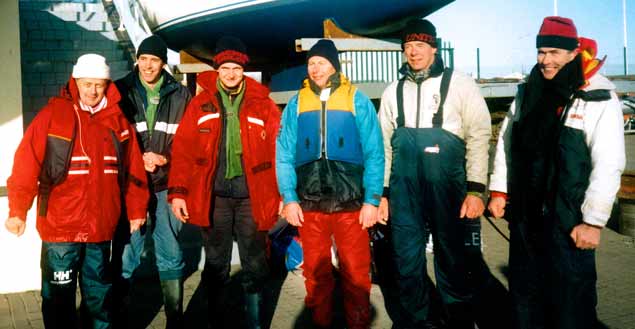 The crew returned from Carrickfergus starting to de-frost in the early morning sun at Howth YC on Monday April 13th 1998 are (left to right) Ian Malcolm, Ian Massey, Damien Cronin, Davy Jones, Nick Massey and Paddy Cronin
The crew returned from Carrickfergus starting to de-frost in the early morning sun at Howth YC on Monday April 13th 1998 are (left to right) Ian Malcolm, Ian Massey, Damien Cronin, Davy Jones, Nick Massey and Paddy Cronin
Not even the damage sustained by seven boats on Howth’s East Pier during Storm Emma on Friday 2nd March 2018 has daunted the Class’s remarkable spirit. The historic Long Shed in which they were stored may had its roof stoved-in by huge breaking seas, but miraculously only two of the seven boats within were very seriously damaged. Thanks to the skills of multi-talented boat-builder Larry Archer, five are already seaworthy again, while the severely-damaged Rosemary is into a major repair job which should have her sailing by the summer, and the most-damaged boat of all, Anita of 1900-vintage, is being researched for further progress as a national or international re-build project.
These wonderful old boats have a lot of sailing in them yet.
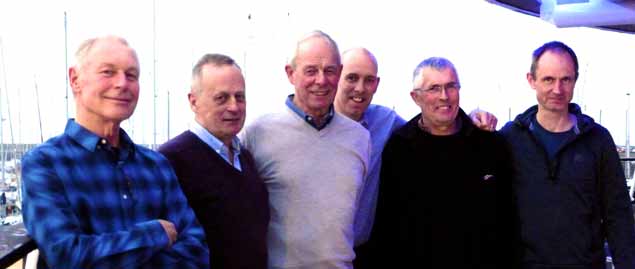 The Centenary Crew of 1998 re-united at Howth YC on Friday April 13th 2018 are (left to right) Davy Jones, Ian Malcolm, Nick Massey, Ian Massey, Paddy Cronin and Damien Cronin
The Centenary Crew of 1998 re-united at Howth YC on Friday April 13th 2018 are (left to right) Davy Jones, Ian Malcolm, Nick Massey, Ian Massey, Paddy Cronin and Damien Cronin
Storm Emma Attacks Historic Howth 17s
The Howth 17 class – founded 1898 and the world’s oldest continuously sailing one design keelboat class - have endured a severe body blow after last night’s uniquely severe Force 12 northeast gales wrecked the roof of the shed in the complex of buildings near the East Pier lighthouse, where the boats have had winter storage since the class’s foundation 120 years ago writes W M Nixon.
Seven of the boats from a class of twenty were stored in the shed, which was severely damaged at least once before, in a similar gale in 1978. But this time the damage to the building’s structure appears more devastating. Owing to sea and tide conditions, the area is unreachable until at least mid-afternoon, but a meeting in the clubhouse at 3.0pm today (Friday) will take decisions on the first steps to deal with the situation.
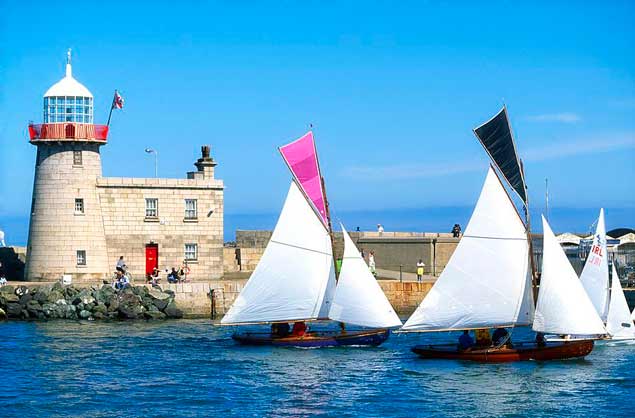 Two of the classic Howth 17s in summer weather. The storage sheds which were severely damaged last night are on the pier on the right
Two of the classic Howth 17s in summer weather. The storage sheds which were severely damaged last night are on the pier on the right
Waves continue to break over the pier at lunch time today
Ireland’s Contribution to the International Classic Wooden Boat Movement
The traditional and classic wooden boat-building movement is gaining momentum in many parts of the world. It can be part of educational and training schemes which provide skills and purpose in life, usually for young people but also for older folk seeking a new and very absorbing interest. Or it could be to preserve an indigenous boat type whose very survival is at risk. Then again, it may be for the simple pleasure of creating something which produces a tangible result from a satisfying personal project, or a worthwhile community effort. Whatever the reason, Irish sailing’s long history enables it to make a unique contribution to today’s proliferation of classic and traditional newly-built or restored craft emerging from workshops large and small in many parts of the world. W M Nixon looks at some aspects of a fascinating trend.
The half century or so between 1890 and 1945 will be seen by most historians as a period of exceptional global hostility, certainly as measured by the number of wars which were fought during it. So it’s remarkable that an activity like recreational sailing, which needs peaceful conditions to thrive, should have developed so much during that turbulent time.
Admittedly much of the development took place in the “Golden Era” between 1890 and the outbreak of World War I in 1914. But progress was being made in sailing for much of the rest of the period despite the often unfavourable conditions. And for Ireland, that historic time of progress is being reflected today in the number of historic designs for Irish classes which are now first choice for boat-building schools, and other special projects, in many countries including Ireland itself.
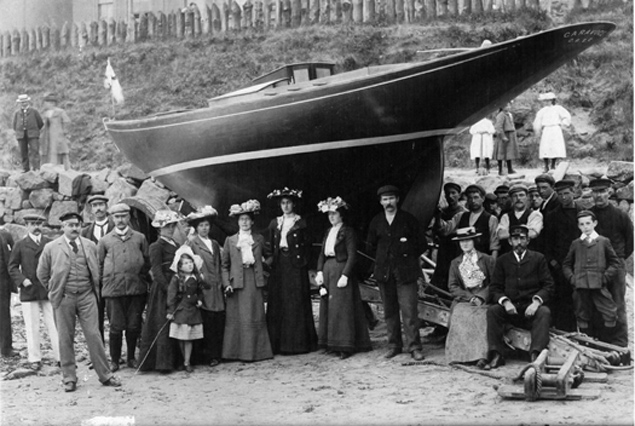 The Alfred Mylne-designed Dublin Bay 21 Garavogue, new-built and ready for launching by James Kelly of Portrush in 1903. Photo courtesy Robin Ruddock
The Alfred Mylne-designed Dublin Bay 21 Garavogue, new-built and ready for launching by James Kelly of Portrush in 1903. Photo courtesy Robin Ruddock
During that half century between 1895 and 1945 when many new local one design classes appeared, Ireland had a pioneering role, as the One Design concept had been first promoted by Thomas “Ben” Middleton’s Water Wags in Dublin Bay in 1887. Thus it was always an innovation which had special resonance in the Irish context, an ideal which it seemed only natural to follow.
Then too, the Royal Alfred YC of Dublin Bay had been promoting the virtues of amateur sailing since 1870 and earlier, so the level playing field provided by One-Designs was a natural follow-on for continuing such enthusiasm. But sustained and long-time support for a particular One-Design type – once it had proved itself satisfactory for the waters on which it sailed – also had much to do with the geography and social structure of Irish sailing.
Put simply, most sailors of the new and growing one design classes in Ireland lived in close proximity to where their boat were based and raced. In contrast elsewhere, thanks to the comprehensive 19th Century railway systems very effectively serving large conurbations such as London and Paris - and to a lesser extent Glasgow and New York - when the weekend was over, many owners and crews headed back to town, sometimes over quite long distances from their boat’s home port.
 Garavogue in the final stages of a race when the finishes were still within Dun Laoghaire Harbour. Her owner and crew would have lived within easy reach of the harbour, and the comfortable social bonds within the DB21 class contributed to its long life from 1902 to 1986.
Garavogue in the final stages of a race when the finishes were still within Dun Laoghaire Harbour. Her owner and crew would have lived within easy reach of the harbour, and the comfortable social bonds within the DB21 class contributed to its long life from 1902 to 1986.
But in Ireland, whether it was Cork, Dublin or Belfast, the boat was always nearby, you might meet your fellow sailors quite often during the working week, and evening racing was an important part of the programme. In the greater Dublin area in particular, the cohesive nature of society meant that once a class was popularly established, it thrived so much that some boats from the late 1890s and early 1900s are still in existence and actively racing today.
This means that when a boat-building school seeks a meaningful design which will give added depth to their activities, they know they only have to turn to the wide selection of historic Irish classes to find a boat of suitable size which will have an element of international recognition, it will give those building her an encouraging sense of connection to the past for instructors and trainees alike, and at a practical level, they know there’ll be a diligent class measurer to keep them on track as the job progresses.
A further alternative technical element is added when the no-longer-seaworthy old hull of a revered classic is acquired, and it is then patiently analysed in a process which is a mixture of dissection, re-build and re-creation. Either way, whether building from scratch, or re-creating through various levels of re-building, the learning process is given many useful extra facets.
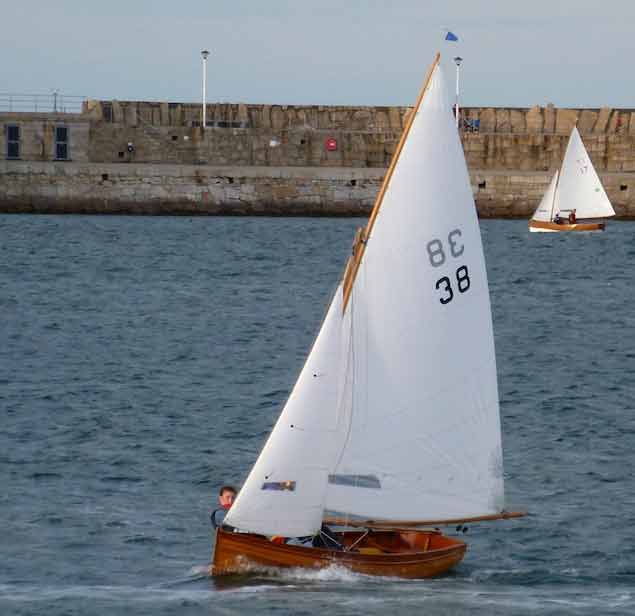 Water Wags in Dun Laoghaire Harbour. Founded as a class of 13-footers in 1887 and re-born in this larger 14ft 3in version by designer Maimie Doyle in 1900, they have become one of the most popular Irish classic designs for boat-building schools. Photo: W M Nixon
Water Wags in Dun Laoghaire Harbour. Founded as a class of 13-footers in 1887 and re-born in this larger 14ft 3in version by designer Maimie Doyle in 1900, they have become one of the most popular Irish classic designs for boat-building schools. Photo: W M Nixon
And as Irish sailors were not shy in asking designers of international repute to create their new One Designs for them, these re-build or new-build projects may have the added lustre of classic stardom with their undoubted historical significance. Thus in recent years while we may have had new boats being built to the old designs of Irish designers such as Maimie Doyle, Hebert Boyd, John B Kearney and O’Brien Kennedy, equally builders from abroad have been in touch with class associations and other sources in Ireland in order to re-create boats to the designs of William Fife and Alfred Mylne of Scotland, and Morgan Giles of England.
Thus at the moment we have Water Wags being built in Spain and America, Dublin Bay 24s are at various stages of being re-created in Spain, America and France, in France they have also built a Howth 17, another Water Wag and a Shannon One Design, it’s said there’s a Howth 17 being built in the boat-building training school attached to the US Naval Academy in Annapolis, and not surprisingly we hear of enquiries made of Irish class association from those havens of DIY boat-building enterprise, Australia and New Zealand.
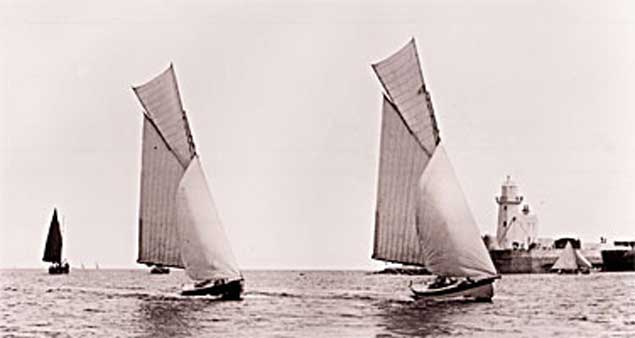 Two of the new Howth 17s in their first season in 1898, before sail numbers had been allocated.
Two of the new Howth 17s in their first season in 1898, before sail numbers had been allocated.
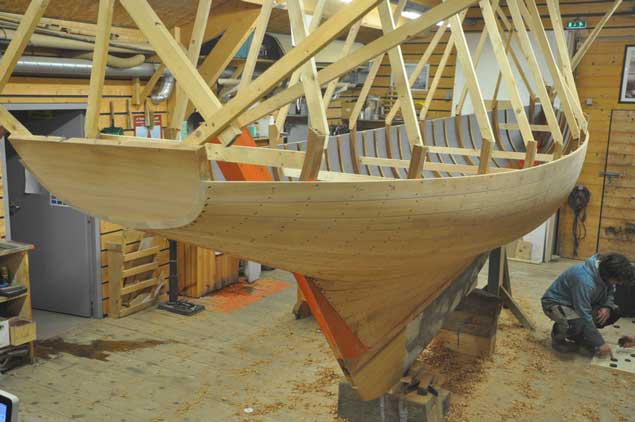 The Howth 17 Orla under construction at the Skol ar Mor boat-building school in France, May 2017
The Howth 17 Orla under construction at the Skol ar Mor boat-building school in France, May 2017
In fact, if we look at the range of living or still very well remembered classes in Ireland which have the potential to make designs available for such classics projects, the choice is remarkably comprehensive in size and type. They range through the 14ft IDRA 14s (O’Brien Kennedy, 1946), the 13ft and now 14ft 3ins Water Wags (R A MacAllister 1887 & Maimie Doyle 1900), the Castletownshend Ettes of the 1930s come in at 16ft, at 17ft you have both the Shannon One Designs (Morgan Giles 1922) and the Mermaids (John Kearney 1932), at 18ft we’re already into keelboats and the Belfast Lough Waverleys (John Wylie 1902), move up to 22ft and you have the Linton Hope-designed Fairy Class (1902) on both Belfast Lough and Lough Erne, and there were also the Fife-designed Belfast Lough Class IIIs of 1896, and then at 22ft 6ins there are the Howth 17s by Herbert Boyd (1898).
Up at 25ft there are the Glens (Alfred Mylne, 1945) in Dun Laoghaire Harbour and on Strangford Lough, and also on Strangford Lough at 28ft 6ins there are the Rivers (Alfred Mylne, 1920). Moving towards the 30-31ft mark, we have the Cork Harbour One Designs (William Fife 1896) and the Dublin Bay 21s (Alfred Mylne 1902), and finally above that, with all of them around the 37ft 6ins LOA size, are the Belfast Lough Class I (Fife 1897), the Dublin Bay 25s (Fife 1898) and the Dublin Bay 24s (Mylne, 1938).
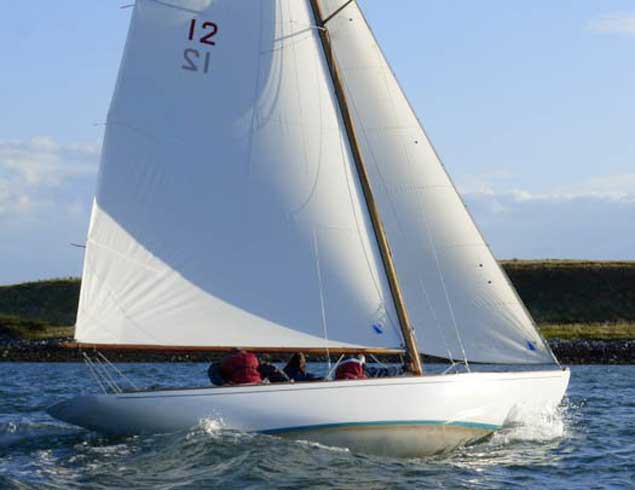 Strangford Lough River Class – designed by Alfred Mylne in 1920, they are believed to be the world’s first Bermudan-rigged One Design. Photo: W M Nixon
Strangford Lough River Class – designed by Alfred Mylne in 1920, they are believed to be the world’s first Bermudan-rigged One Design. Photo: W M Nixon
 The Dublin Bay 24 Periwinkle, an Alfred Mylne design of 1938, was restored in France
The Dublin Bay 24 Periwinkle, an Alfred Mylne design of 1938, was restored in France
The attraction of such a good selection is that anyone minded to re-create a classic with a distinguished design and sailing provenance can choose a boat of manageable size from the range available in Ireland. A genuine classic doesn’t have to be a biggie. Keeping it manageable – and in many cases keeping it comfortably trailerable – is the secret of a harmonious project, and the eclectic list of classic projects available for sourcing in Ireland not only offers boats of every size and type up to 40ft, but you can come to Ireland and absorb the atmosphere of the places where the idea of the boat was first conceived, and meet current enthusiasts for sailing the boat which gives a vibrant connection both to the present and the past.
Don’t assume, though, that though it may be happening abroad, there’s nothing going on in Ireland. On the contrary, the possibilities of the Irish classics have been exploited every which way. Serial classics enthusiast Hal Sisk of Dun Laoghaire has instigated so many projects that it’s difficult keeping track, but his CV includes the Peggy Bawn, new Water Wags built in classic style, glassfibre Colleens from an 1897 design, and currently the building of a Dublin Bay 21 from the original ballast keel upwards by Steve Morris of Kilrush, utilising multi-skin construction based on laminated frames.
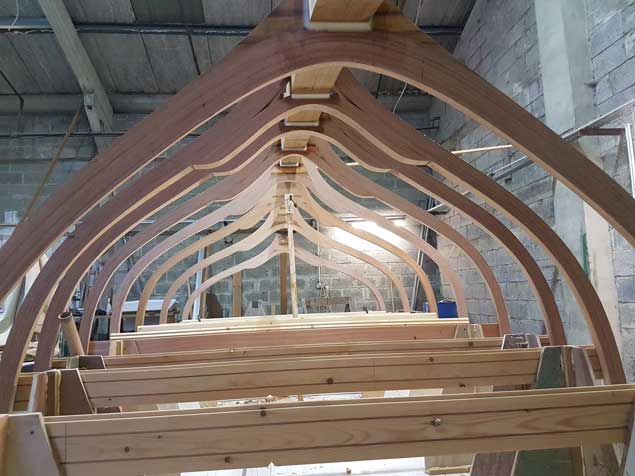 New life for the 1902-designed DB 21 Naneen in Steve Morris’s workshop in Kilrush. Photo: Steve Morris
New life for the 1902-designed DB 21 Naneen in Steve Morris’s workshop in Kilrush. Photo: Steve Morris
 The construction method may be new, but that’s undoubtedly the classic hull of a DB 21 emerging in Kilrush. Photo: Steve Morris
The construction method may be new, but that’s undoubtedly the classic hull of a DB 21 emerging in Kilrush. Photo: Steve Morris
As for Jimmy Furey on the Roscommon shores of Lough Ree, his examples of completely traditional classic style construction of Shannon One Designs and Water Wags – working most recently with Cathy MacAleavey – results in what can only be described as Chippendale work, while down in Ballydehob in West Cork there’s a whole nest of classic restorers, with Rui Ferreira setting quite a pace with new Ettes, a restored Kim Holman Stella, and a much-revived Howth 17.
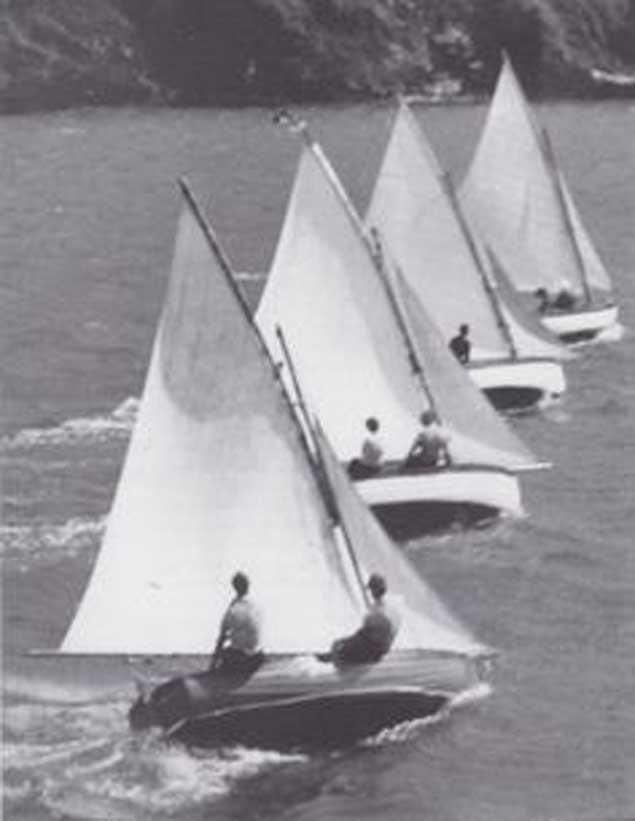 The Castlehaven Ette Class – Rui Ferreira has been building to this design
The Castlehaven Ette Class – Rui Ferreira has been building to this design
Over on the east coast, when times are hectic in classic boatbuilding, people have found that John Jones over in Anglesey does a very good line in stylish clinker construction, but the venerable Howth 17s – not all of which are operated on large budgets – are currently being kept going by Larry Archer of Malahide, who has a workshop up-country where three of these golden oldies are currently receiving the TLC.
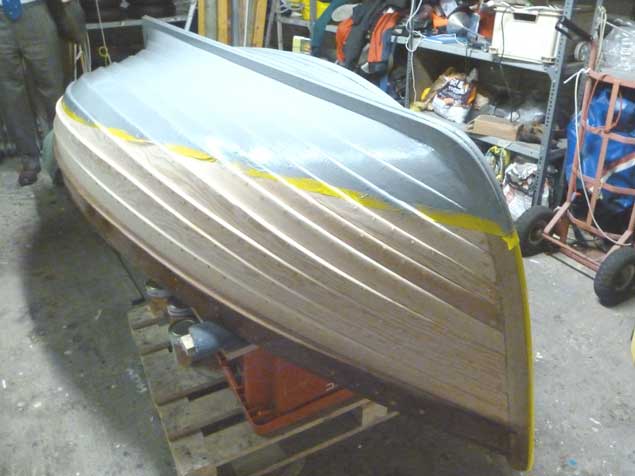 Asgard’s dinghy was re-created in classic style by Larry Archer. Photo: W M Nixon
Asgard’s dinghy was re-created in classic style by Larry Archer. Photo: W M Nixon
Larry is something of a renaissance man in the boat maintenance, repair and building arena, as he is right up to speed with everything to do with glassfibre, yet when Pat Murphy and his group got together to re-create Asgard’s dinghy, it was Larry Archer who delivered the goods, beautifully built in classic clinker style.
As to his present work with the Howth 17s, that is part of a broader project being driven by Ian Malcolm and fellow Seventeen sailors, who may be looking at a class of 23 boats in the foreseeable future. Apart from the new boat built last year in France and the boat reputedly under construction in Annapolis, in a secret workshop on the Hill of Howth, yet another new Howth 17 is quietly under construction to a very high standard.
Such things take time, as the group in Clontarf Y & BC demonstrated when they set out to build a classic timber IDRA 14 for the class’s 70th Anniversary in 2016. They allowed themselves plenty of time, but it was tight enough in the end, yet by the successful conclusion a special bond had been formed among the build team in their Men’s Shed enterprise. It said everything about the deeper benefits of getting involved in a manageable project using time-honoured methods and traditional materials to create something of lasting beauty, value and utility.
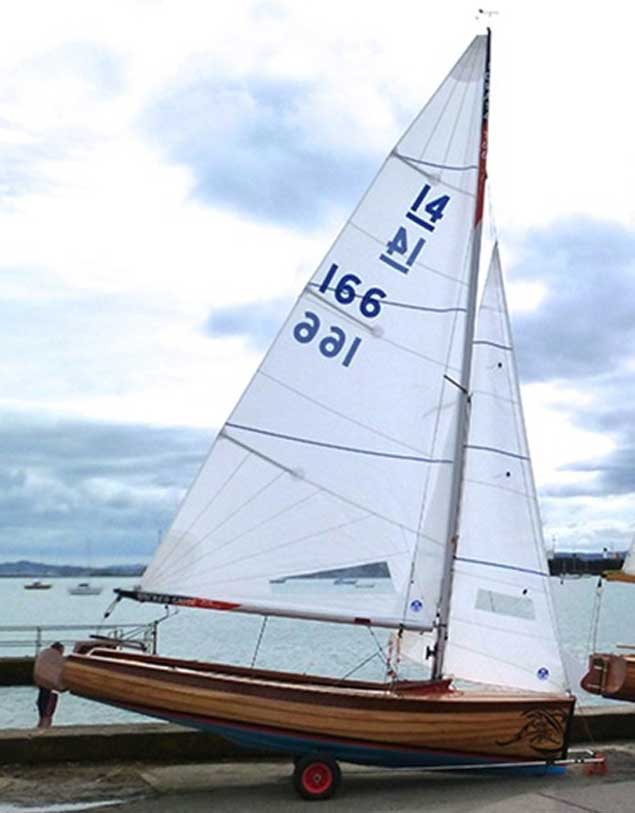 The new IDRA 14 ready for launching at the class’s 70th Anniversary Regatta at Clontarf. Photo: W M Nixon
The new IDRA 14 ready for launching at the class’s 70th Anniversary Regatta at Clontarf. Photo: W M Nixon
'Dalkey Boat' Wins Historic Howth 17 Championship
The Massey family’s 1907-built Deilginis of Howth Yacht Club has retained the Howth Seventeen Annual Championship after a five–race series concluded on Saturday with a countback following a points tie with the 1910-built Oona (Peter Courtney) writes W M Nixon.
The combined age of the boats taking part in this well-supported event was 1,487 years. And though this oldest active keelboat class in the world has a strong presence of younger sailors in its makeup of crews, the fact that many boats now find they do best four up meant that the total combined ages involved with people and boats soared through the 2,000 years mark.
But in mostly ideal conditions, Race Officer Neil Murphy was able to get in a complete programme which would have been envied by many younger classes, thanks to putting through a preliminary race on Friday evening, sailed in sunshine and a brisk southwest to west breeze.
 The Friday evening race in a brisk sou’west to west breeze sent the Howth Seventeens away from a traditional pier start through the Sound inside Ireland’s Eye. Photo: W M Nixon
The Friday evening race in a brisk sou’west to west breeze sent the Howth Seventeens away from a traditional pier start through the Sound inside Ireland’s Eye. Photo: W M Nixon
Although Conor Turvey helming the 1988-built Isobel had the best of the start, by the finish Luke Massey had brought Deilginis through to the lead, and at the line it was Deiliginis, Oona and Roddy Cooper’s 1898-built Leila taking the honours.
However, the real excitement was back in the midst of the fleet, where Transatlantic Solo Race winner Conor Fogerty was guest helming aboard the Lynch family’s Echo. In a close encounter on a rolling run with Eileen, the latter’s mainsail came in across the Lynch boat, and their star visiting helm found himself wrapped up in Eileen’s mainsheet, and hauled into the sea.
Any talk of being Lynched was reckoned in the worst possible taste as they got the right people aboard the right boats. And nothing daunted, the Atlantic veteran raced on despite being soaked to the skin, though the 14th place recorded by Echo became her discard.
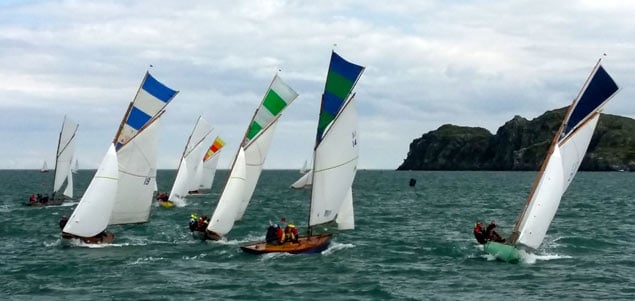 Saturday at first brought plenty of breeze, but topsails were carried throughout. Photo: Neil Murphy
Saturday at first brought plenty of breeze, but topsails were carried throughout. Photo: Neil Murphy
Things were back to normal in the morning, and Saturday’s packed programme was staged in a west to nor’west breeze which was marginal for topsails at first, but with the forecast for wind strengths to ease as the day went on, the fleet went forth with full sail set.
It was intriguing to note the different levels of skills being shown in the arcane arts of setting a jackyard tops’l. The fact that Peter Courtney’s family have been involved with the class since 1907 suggests that it’s an inherited talent, as the topsail on Oona was in place to perfection, setting as one with the mainsail, whereas some other boats had inefficiently large gaps between the jackyard and the gaff.
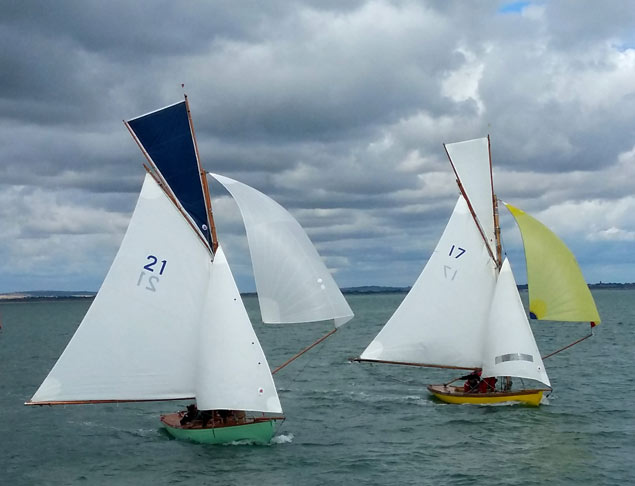 The new French-built Orla (Ian Malcolm, left) and Peter Courtney’s Oona, which had the best-set topsail in the fleet. Photo: Neil Murphy
The new French-built Orla (Ian Malcolm, left) and Peter Courtney’s Oona, which had the best-set topsail in the fleet. Photo: Neil Murphy
Despite the style of her topsail setting, Oona was back in third in Saturday’s first race, but Deilginis was on a roll with another win. However, the Courtney boat then moved rapidly up the ranking with two firsts in Saturday’s second and third races, while Deilginis logged a sixth and a second. This meant they were head to head in the final race with Deiliginis in cover on Oona, while the brand-new French-built Orla (Ian Malcolm) read a windshift to perfection to take the win, with second going to the Turveys and Isobel, and Deilginis and Oona coming in third and fourth.
With them tied on 7.0pts after discards, the quick judgment was that Oona must have it, as she discarded a fourth while Deilginis dropped a sixth, and they both had a scoreline of two firsts, a second and a third. But somewhere in the deepest depths of World Sailing Rules it apparently says that in the event of a tie, the placings in the final race are the decider, with discards ignored, so Deilginis retained the title she won in 2016, with Oona second, Isobel third and the new Orla fourth on a 4th, 5th, 6th and 1st, with an 11th discarded.
In a class of this size, the availability of handicaps adds greatly to the commitment of the fleet, and the placings in this division were 1st Gladys (Pat Heydon), 2nd Bobolink (Doyle/Finnegan/Walsh), 3rd Silver Moon (Susan Morgan) and 4th Erica (Ian Byrne and Eddie Ferris).
 The breeze eased on Saturday as the day went on, but the full programme was completed. Under the rules of the class, it is obligatory to carry the entire spinnaker on the weather side. Photo: Neil Murphy
The breeze eased on Saturday as the day went on, but the full programme was completed. Under the rules of the class, it is obligatory to carry the entire spinnaker on the weather side. Photo: Neil Murphy
As to a Howth championship being won by “the Dalkey boat”, it goes back into the mists of time, when Dublin Bay Sailing Club were casting about around 1906, looking for a seaworthy little keelboat class. Having searched high and low, it was pointed out to them that a well-proven little class was hidden round on the other side of Howth Head. Apparently they were called the Howth Seventeens, and the word was they did the business as regards seaworthiness and good racing.
So in classic Kingstown style, Dublin Bay Sailing Club adopted the design, immediately renamed them the Dublin Bay Seventeen, and ordered seven to be built by James Kelly in Portrush on the north coast, for delivery to Kingstown on flatbed railway trucks in time for the 1907 season.
Leading this movement was Dr W M A Wright who was to become DBSC Commodore in 1919. But in 1907, to underline the Dublin Bay character of his new Seventeen footer, he called her Deilginis, after that place which has been known as Dalkey ever since the Vikings passed through.
 The Massey family’s 1907-built Deilginis, Howth 17 Champion 2017, was retrieved from the canal bank in Dolphin’s Barn in Dublin in a tarred and derelict state in 1971. Photo: Neil Murphy
The Massey family’s 1907-built Deilginis, Howth 17 Champion 2017, was retrieved from the canal bank in Dolphin’s Barn in Dublin in a tarred and derelict state in 1971. Photo: Neil Murphy
Deilginis was a star of the Dun Laoghaire yachting scene for years, but by 1970 when Nick Massey was in the heart of the movement to re-locate all the boats to Howth, the word was that Deilginis was in a state of dereliction, with evidence of tar being deployed, on the banks of the Grand Canal at Dolphin’s Barn in Dublin.
We just don’t have the space, time or knowledge to explain how Dolphin’s Barn got its name. Sufficient to say that Nick and his siblings and shipmates managed to retrieve what was left of Deilginis around 1970, and her path has been onwards and upwards ever since, with this past weekend yet another waypoint on that magic route.




























